Last updated: July 8, 2025
Have you ever heard of flea dirt in dogs? If you haven’t then now is the time to add to your research. Flea dirt, which looks like typical dirt, is the excrement that fleas make when they feed on the blood of animals, especially dogs. The signs of flea dirt in dogs is the presence of this dark, gritty material, which is composed of digested blood. One of the most telling signs that a dog has fleas is the presence of flea filth on its fur, skin, or bedding.
In this article, I will discuss what is flea dirt in dogs, how it can hurt dogs and finally, how can you prevent the occurrence of the same. If you wish to be the best dog guardian for your pup, now is the time to start. Click on the subscription option in the sidebar so that I can send you the latest tips and tricks from the dog care world the moment the next blog post releases. If you like watching videos, subscribe to the YouTube channel of The Happy Puppers, Shruti, and Delta. Remember to ring the notification bell and set it to ALL so that YouTube never misses notifying you about the release of any of the new videos from the channel.
“Regular grooming is key to spotting flea dirt early, which signals an active flea infestation. Using vet-approved treatments promptly can prevent serious issues like flea allergy dermatitis.”
— Dr. Sandra Wooten, DVM, cited in PetMD
Topics covered in this blog post
What is Flea Dirt?
Flea dirt, often mistaken for regular dirt, is actually the feces of fleas. It’s composed primarily of digested blood that fleas excrete after feeding on your dog’s blood. Visually, flea dirt looks like tiny, dark specks, resembling ground black pepper or coffee grounds, and is commonly found on your dog’s skin, fur, or bedding. These specks are typically reddish-black or dark brown and may appear in clusters, especially in areas where fleas congregate, such as the base of the tail, belly, or lower back.
To confirm if the specks are flea dirt, you can perform the “paper towel test.” Place the specks on a damp white paper towel; if they dissolve into reddish-brown smears, it’s flea dirt due to its blood content. This is a telltale sign of an active flea infestation, as flea dirt is only produced by adult fleas that have fed on your dog. Ignoring flea dirt can lead to health issues like flea allergy, dermatitis, anemia, or even tapeworm infections, making early detection crucial for your pup’s well-being (PetMD).
Why should you remove Flea Dirt from Dogs?
For multiple reasons, it is critical to address flea dirt in dogs. First, it lets dog guardians know when there might be a flea infestation, so they can take action before the problem gets worse. In addition to being a nuisance and skin irritant for dogs, fleas pose a health concern to humans and other pets by transmitting parasites and diseases.
Ignoring flea dirt in dogs can also cause the flea population to spike, which makes the problem worse and harder to control. Fleas are known to multiply quickly, and if left untreated, an infestation can cause severe itching, allergic reactions, and even anemia in dogs.
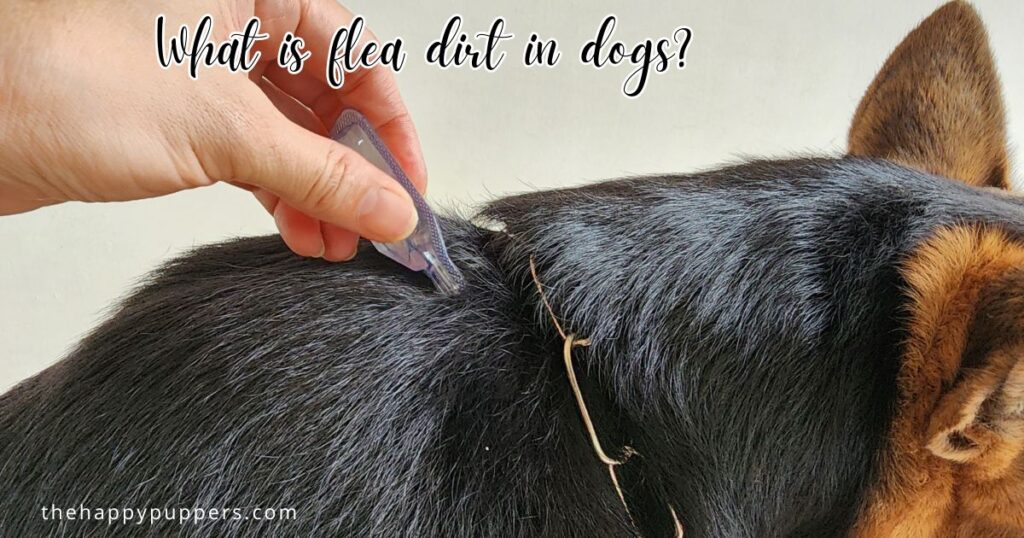
The mental and emotional wellness of both the dog and its guardians are just as important as their physical health. A dog’s conduct and quality of life can be greatly affected by chronic discomfort and itching. It is crucial to deal with flea filth for the sake of the pet’s health and the safety of the entire home because fleas can transmit diseases to humans.
It is crucial to take a proactive strategy in this setting to identify and treat flea dirt in dogs. To promote a happy cohabitation between pets and their human caretakers, it is essential to regularly groom dogs, take preventative measures, and intervene promptly with appropriate flea control solutions. The comprehensive plan outlined in this blog post will ensure that dogs are healthy and comfortable.
There are multiple reasons:
For multiple reasons, it is critical to address flea dirt in dogs. First, it lets dog guardians know when there might be a flea infestation, so they can take action before the problem gets worse. Fleas can lay up to 50 eggs daily, rapidly increasing the infestation if untreated (Blue Cross). Up to 10% of dogs may develop flea allergy dermatitis from bites, causing severe itching and infections (PetMD). Additionally, fleas can transmit tapeworms, affecting 1 in 5 dogs with untreated infestations (Warrick Veterinary Clinic). In addition to being a nuisance and skin irritant for dogs, fleas pose a health concern to humans and other pets by transmitting parasites and diseases.
Flea Dirt vs. Dandruff
Distinguishing flea dirt from dandruff is essential for proper treatment, as they require different approaches. Here’s a breakdown of the key differences:
- Appearance: Flea dirt appears as small, dark, pepper-like specks, often reddish-black or dark brown. Dandruff, on the other hand, is typically white or light gray, presenting as flaky, dry skin particles.
- Texture and Location: Flea dirt is granular and often found in clusters on the skin or tangled in fur, especially in flea-prone areas like the tail base or belly. Dandruff is flatter, flakier, and more evenly distributed across the coat or skin.
- Paper Towel Test: When placed on a damp paper towel, flea dirt dissolves into reddish-brown stains due to its blood content. Dandruff remains white or gray and does not change color when wet (Chewy).
- Associated Symptoms: Flea dirt is accompanied by itching, scratching, or red bumps from flea bites. Dandruff may cause mild itching but is often linked to dry skin or allergies, not parasitic activity.
If you’re unsure, consult your veterinarian to confirm whether your dog has fleas or a skin condition like dandruff. Misdiagnosing can delay effective treatment and worsen your dog’s discomfort.
The Telltale Signs of Flea Dirt in dogs Versus Common Debris:
The ability to differentiate flea dirt from ordinary dirt or debris is vital for pet owners. Instead of dissolving in water, flea dirt tends to create tiny, reddish-brown streaks when it gets wet. This feature makes it easier to distinguish it from ordinary dirt, which improves the accuracy of identification.
In addition, flea dirt in dogs is most concentrated in locations where fleas like to hang out, like the fur around the neck, the belly, and the base of the tail. To catch flea dirt early and prevent a full-blown infestation, regular brushing and careful inspection of a dog’s coat are vital.
Flea Dirt vs. Dandruff vs. Dirt: A Quick Comparison
| Characteristic | Flea Dirt | Dandruff | Regular Dirt |
|---|---|---|---|
| Appearance | Small, dark, reddish-black specks, like ground pepper | White or light gray flaky particles | Brown or black, irregular clumps |
| Texture | Granular, gritty | Flat, flaky, dry | Clumpy, uneven |
| Location | Clusters near tail base, belly, neck | Evenly spread across coat or skin | Scattered, not specific to areas |
| Paper Towel Test | Turns reddish-brown when wet | Stays white or gray when wet | No color change when wet |
This table helps you quickly identify whether your dog has flea dirt, dandruff, or just regular dirt, ensuring the right treatment approach.
Why Flea Dirt in dogs Is Related to Flea Infestations:
The presence of flea dirt in dogs is a sure sign of a flea infestation. As part of their feeding process, fleas release flea filth into the bloodstream. Being a waste product of flea feeding, the presence of flea dirt indicates an active infection. The necessity of flea management procedures can be confirmed by identifying flea filth.
To provide successful pet care, it is crucial to understand this connection. Dogs can experience discomfort, allergic reactions, and even health problems as a flea infestation worsens if not addressed. If you want to keep your home healthy for your pet and yourself, it’s a good idea to check for flea dirt on a regular basis. This will help you manage and prevent flea infestations.
Detection of Flea Dirt in Dogs
Flea Dirt Locations:
The best way for dog owners to find flea filth is to look in the areas where fleas tend to congregate. A few examples are:
- Because fleas tend to cluster at the base of the tail, that’s a good place to look for flea filth (Warrick Veterinary Clinic).
- Fleas can hide in the fur around your dog’s groin and abdomen, so be sure to check those areas.
- Fleas may also prefer to live in certain areas, such as behind the ears and on the neck. Look for evidence of flea filth by thoroughly examining these locations.
- Fleas might be hiding in the space between the toes and the paw pads. Take a good look at these spots.
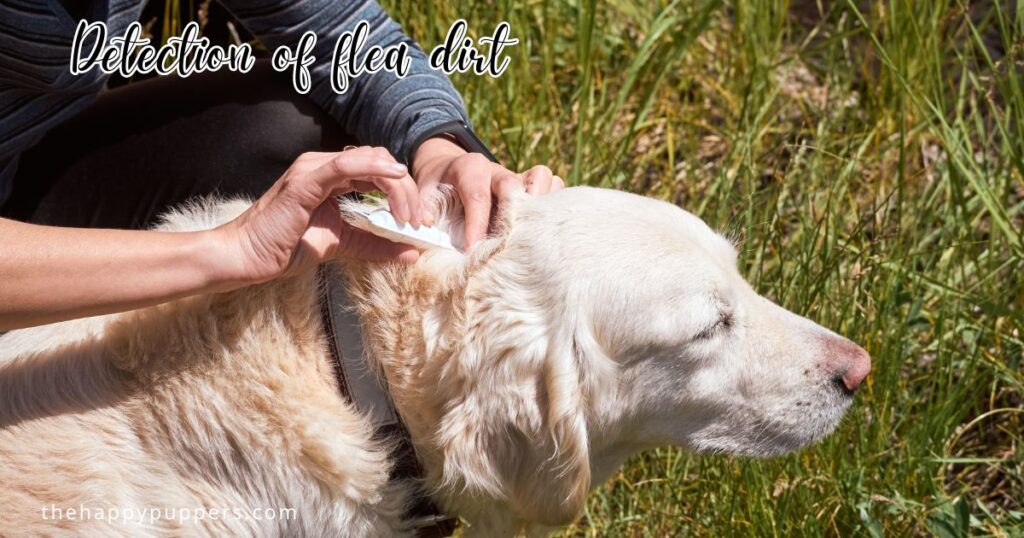
You can improve your chances of finding flea dirt early and treating the infestation swiftly by brushing your pet regularly and inspecting these important areas thoroughly.
Warning Signs of Flea Dirt in Dogs:
When you look for flea dirt on a dog, you might also notice these telltale symptoms of an infestation:
- Fleas could be the cause of persistent biting, licking, or scratching, particularly in and around the tail and hindquarters.
- Flea bites can make your dog’s skin look red, irritated, and even develop little bumps.
- Affected areas prone to fleas may experience hair loss as a result of excessive biting and scratching.
- The itching and restlessness that flea bites can cause might make flea-infested dogs act agitated or restless.
- The adult fleas can be seen on the skin or fur of the dog.
The Value of Prompt Identification:
There are various reasons why it is crucial to discover flea filth and infestation indications early on:
- Dog guardians can take proactive steps to avoid a full-blown flea infestation if they are able to identify flea soil early on.
- If you take care of fleas quickly, your dog won’t have to deal with as much itching and discomfort. This in turn will keep him from developing skin problems and hair loss.
- Fleas can spread parasites and diseases. These health problems can affect not only the dog but also other members of the household if not caught early.
- When intervention is done early, flea management becomes more manageable. This leads to easier treatment. It simplifies treatment by lowering the probability of widespread environmental contamination.
Overall, it’s important to be able to see flea dirt in dogs and other symptoms of infestation quickly. This way you may protect your dog and stop fleas from spreading in your home. Flea management tactics that work rely on constant vigilance and quick responses.
Pin this article for later:
The Dangers of Flea Infestation on Human Health
Flea-Related Illnesses and Pain:
Many health problems, including the spread of diseases caused by fleas, can result from flea infestations in dogs. Tapeworms, Bartonella (cat scratch fever), and Rickettsia (different spotted fevers) are among the diseases that fleas can transmit (PMC). Fleas cause pain and suffering for the dog since they feed on it constantly and bite it.
Fatigue, fever, and gastrointestinal problems are symptoms of flea-borne illnesses. The significance of thorough flea management procedures is further underscored by the fact that untreated infestations can cause anemia in extreme circumstances, particularly in smaller breeds or puppies.
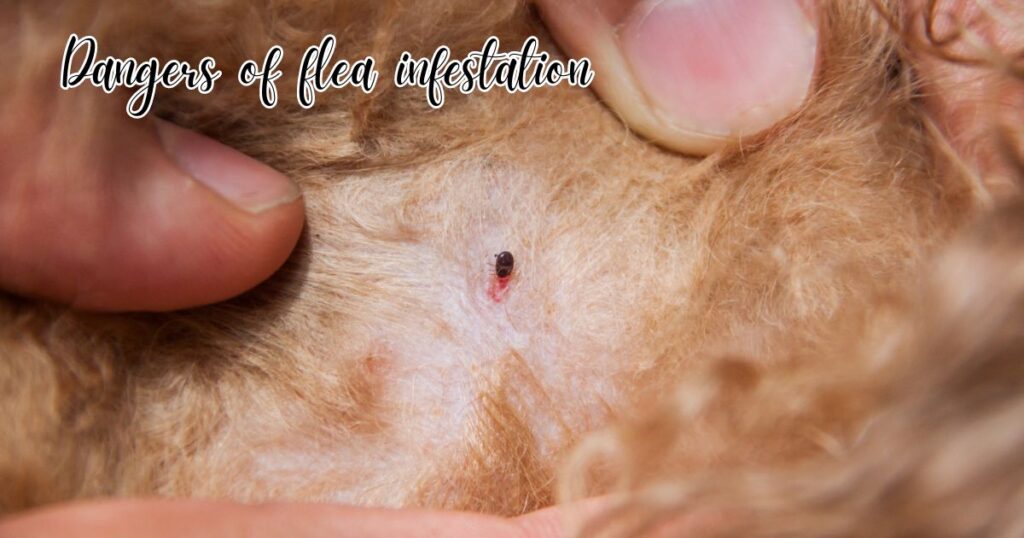
Dog Allergy:
A number of canines get severe allergic reactions when bitten by fleas because their immune systems respond too strongly. A common illness that can be induced by flea saliva is flea allergy dermatitis (FAD). Even a small number of flea bites can cause severe itching, redness, and inflammation in dogs with FAD.
When a dog has an allergic reaction, it hurts like hell. Furthermore, the scratching rips the skin and can cause another infection. The management of allergic reactions and the prevention of the worsening of skin problems depend on the quick identification and treatment of flea infestations.
How Flea Dirt Affects a Dog’s Skin and Coat?
A dog’s skin and coat are directly affected by flea dirt, which is made up of flea excrement and digested blood. Over time, flea filth can collect and cause:
- The debris that fleas leave behind can irritate the skin, causing it to redden and swell. The dog is already in pain, and this irritant is making it worse.
- Flea dirt can aggravate existing skin conditions and even cause secondary infections, such as dermatitis.
- Flea infestations and the debris they leave behind can diminish coat quality, making it look dull, dry, or oily.
- In extreme circumstances, the constant biting and scratching that comes with flea irritation can cause hair to grow unevenly or even fall out entirely.
- Flea filth is a breeding habitat for fleas and adds to the general unhealthiness of a dog’s coat, creating an unhealthy environment. It may bring in even more fleas, which means the infection will go on and on.
The health of a dog’s hair and skin depends on addressing flea dirt through regular brushing, effective flea control measures, and medical care. To ensure the pet’s health and happiness in the long run, it’s important to check in on them often and take action if necessary.
Step-by-Step Guide on How to Remove Flea Dirt
Time needed: 40 minutes
- Prepare Your Supplies
Gather a pet-safe flea shampoo (with pyrethrins or soothing oatmeal), a fine-toothed flea comb, warm water, a tub or basin, towels, and a white paper towel for testing. Ensure the shampoo is formulated for dogs, as some products are toxic to cats.
- Perform the Paper Towel Test
Before bathing, collect specks from your dog’s fur using the flea comb and place them on a damp white paper towel. If they turn reddish-brown, confirm it’s flea dirt and proceed with flea treatment.
- Bathe Your Dog
Place your dog in the tub and wet their coat with warm water. Apply flea shampoo, lathering thoroughly, especially in flea-prone areas like the lower back, belly, and tail base. Let the shampoo sit for 5–10 minutes to loosen flea dirt and kill fleas (The Spruce Pets).
- Use a Flea Comb
While the shampoo is on, gently run the flea comb through your dog’s fur, focusing on areas with flea dirt. Dip the comb in soapy water after each pass to drown fleas and remove debris.
- Rinse Thoroughly
Rinse your dog’s coat with warm water to wash away shampoo, flea dirt, and dead fleas. Check the water for dark specks to ensure flea dirt is being removed.
- Dry and Inspect
Towel-dry your dog and inspect their coat for remaining flea dirt. If specks persist, repeat the bath or use the flea comb with a damp rag to exfoliate gently.
- Clean the Environment
Wash your dog’s bedding, blankets, and any soft surfaces in hot, soapy water (at least 60°C) to kill flea eggs and larvae. Vacuum carpets, furniture, and baseboards thoroughly, disposing of the vacuum bag immediately.
Home Remedies for Flea Dirt
Use a Fine-Toothed Comb
A useful do-it-yourself tool for detecting flea dirt is a pet-specific fine-toothed comb. Here are the steps:
- Based on your pet’s fur type, choose a comb with tightly spaced teeth.
- Use a soft comb to gently go through your pet’s fur, being sure to target the regions around the ears, neck, and base of the tail—these are common hiding spots for fleas.
- After every stroke, look for tiny, black particles in the comb. It could be flea dirt if you see little, pepper-like reddish-brown dots.
- Thoroughly examine the dog’s coat by combing over various places. Any evidence of flea filth or mature fleas should be an area of focus.
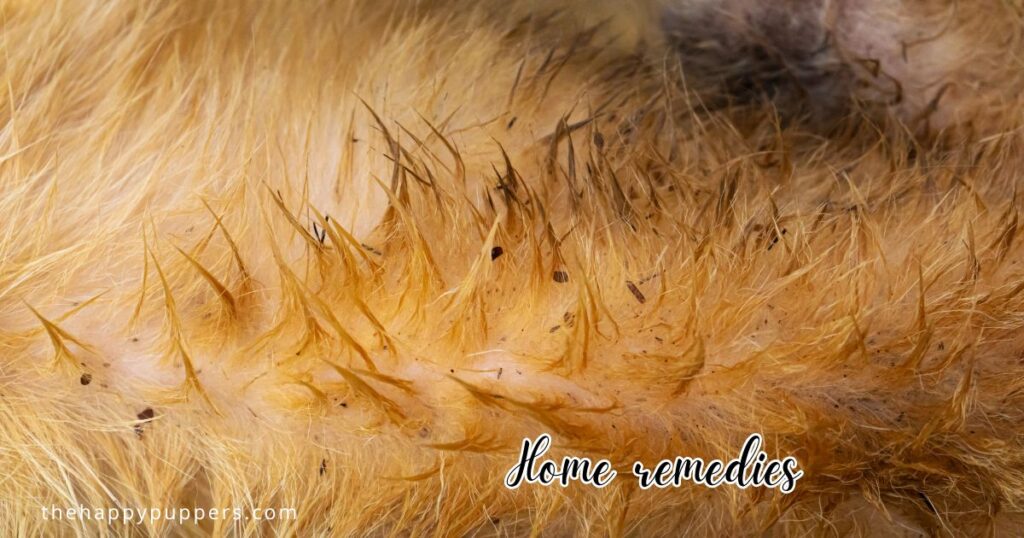
Fabric or White Paper Test:
Checking white paper or fabric for flea filth is an easy and effective method. The way to do it is this:
- Lay out some white paper or fabric on a level surface. Dark flea dirt in dogs stands out more against the white backdrop.
- Utilize a brush or comb to glide your pet’s fur over the white surface, paying particular attention to spots where fleas could be hiding.
- As the dog’s fur lands on the white surface, meticulously look for any grainy, dark spots. The presence of flea filth is indicated by the presence of tiny, reddish-brown granules.
- Verify your results by moistening a portion of the specks. You can be sure of the possibility of the presence of fleas, if the flea dirt become reddish.
Preparing Dog Bedding for Inspection:
One more thing you may do on your own to find flea filth is to look at your pet’s bedding. Here are the steps:
- To make the fleas more visible, pick a white towel or cloth.
- If you are looking for any black particles or specks, inspect your pet’s bedding. Pay close attention to spots where your pet usually takes a nap.
- Take a few dust mites or flea droppings from the bedding and put them in a moist towel.
- Dampen the particles and set them on a white surface. Flea dirt is present when the particles change color to a reddish brown.
By consistently carrying out these do-it-yourself inspections, dog guardians may quickly identify flea filth, allowing for efficient flea treatment measures and rapid intervention to protect their dogs.
How to Get Rid of Flea Dirt
Getting rid of flea dirt involves a two-pronged approach: treating your dog and cleaning your home to eliminate fleas and their debris. Here’s how to tackle it effectively:
Treat Your Dog
Use veterinarian-approved flea treatments, such as oral medications (e.g., Nexgard, Bravecto), topical solutions (e.g., Advantage II), or prescription flea collars (e.g., Seresto). These products kill adult fleas, preventing further flea dirt production. Administer treatments as directed, considering your dog’s weight, age, and health. For immediate relief, give your dog a bath with flea shampoo or soothing oatmeal shampoo to remove existing flea dirt. Regular flea combing can help monitor and remove residual dirt.
Clean Your Home
Fleas and flea dirt can linger in your dog’s environment, leading to reinfestation. Vacuum all floors, carpets, rugs, and furniture every other day, focusing on baseboards, crevices, and areas where your dog rests. Dispose of vacuum contents in a sealed bag outside. Wash pet bedding, blankets, and your own bedding in hot water (60°C or hotter) to kill fleas, eggs, and larvae. Consider using pet-safe flea sprays or foggers for carpets and furniture, but follow product instructions carefully.
Prevent Reinfestation
Apply year-round flea preventatives as recommended by your vet to keep fleas at bay. Treat all pets in the household, as untreated pets can reintroduce fleas. Regularly groom your dog with a flea comb and check for flea dirt, especially after visits to dog parks or boarding facilities. Keep wildlife (e.g., mice, opossums) out of your home, as they can carry fleas.
Consult a Veterinarian
If flea dirt persists despite your efforts, seek veterinary advice. Your vet can check for underlying issues like flea allergy dermatitis or anemia and recommend stronger treatments or environmental solutions, such as professional extermination.
By combining diligent pet treatment with thorough environmental cleaning, you can eliminate flea dirt and protect your dog from the discomfort and health risks of fleas. Stay proactive with regular checks and preventatives to keep your pup happy and healthy.
Flea Treatment for Dogs
Why Seeing a Veterinarian Is Crucial:
Seek the advice of a veterinarian before applying flea medication. Several factors make veterinary advice crucial:
- Veterinarians are able to accurately diagnose flea infestations by confirming their presence and assessing the intensity of the infection.
- Because every dog is different, a vet can design a program specifically for your pet that takes into account its age, overall health, and any preexisting diseases or disorders.
- Flea control treatments prescribed by veterinarians are both effective and safe. In most cases, the efficacy and durability of prescription-only treatments far outweigh those of over-the-counter alternatives.
- Flea dirt in dogs can worsen or even cause preexisting conditions to worsen. A veterinarian can take care of all of these issues together, which is great for health in the long run.
- To make sure your dog doesn’t have any negative responses to flea treatments, it’s important to have a vet keep an eye on him.
Drugstore Options:
You can buy many flea remedies for dogs without a prescription. Among them might be:
- Topical Treatments consist of pesticides that kill fleas when they come into touch with the dog’s skin (Frontline).
- Oral Medications include chewable or pill-shaped medications that kill fleas when they bite the dog by providing systemic protection.
- Flea Collars have pesticides in them that offer a constant defense against fleas.
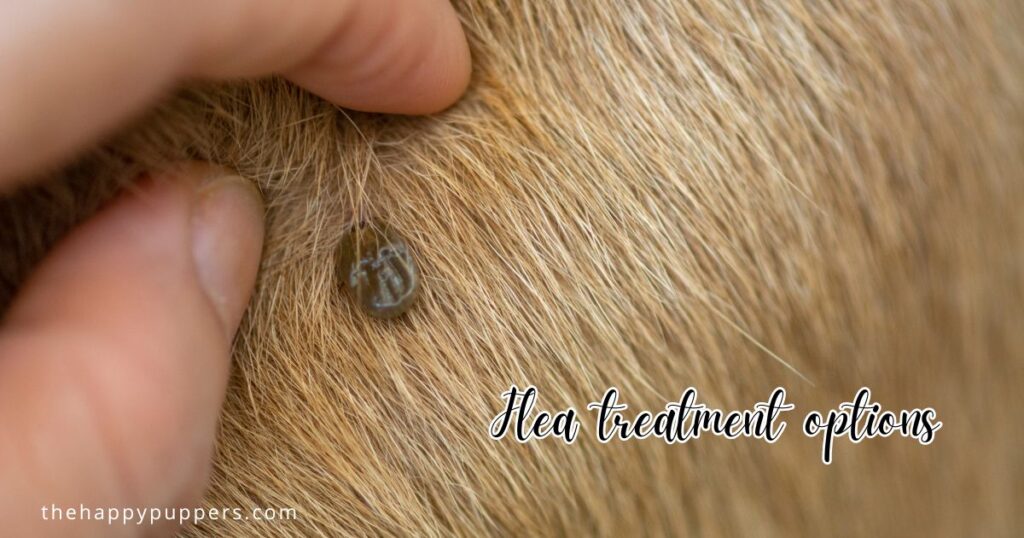
Thoroughly adhere to the product’s directions and dosage suggestions. When selecting over-the-counter remedies for dogs, owners should also take into account the dog’s age, size, and current health condition.
Home Treatments for Fleas: Natural and Organic Options:
When it comes to flea management, some pet owners choose to use natural and home solutions. The degree to which these approaches assist control fleas varies from one person to the next. Popular all-natural cures include of:
- When applied to a dog’s habitat, food-grade diatomaceous earth can dehydrate and kill fleas. Use caution so the dog doesn’t breathe in the powder when administering it.
- Some guardians swear by essential oils, like lavender, eucalyptus, and cedarwood, can keep fleas at bay. Some oils are hazardous to dogs in high doses, so use them with caution.
- Grooming your dog regularly will keep its coat clean and free of fleas and flea filth. One physical method for physically eradicating fleas and their waste is to use a flea comb during grooming.
- A little apple cider vinegar in a dog’s water bowl or sprayed on the coat could keep fleas at bay. Nevertheless, the efficacy differs from dog to dog.
Some people find comfort from using natural therapies, but it’s possible that they won’t be as effective as the medicines provided by veterinarians. For the sake of your dog’s health and safety, it’s best to check with your vet before using any natural therapies.
In conclusion, a thorough strategy for dealing with flea dirt calls for a trip to the vet for personalized recommendations, careful use of over-the-counter medications, and cautious consideration of natural cures under the supervision of an expert.
Preventive Steps
Maintaining a Regular Routine for Personal Hygiene:
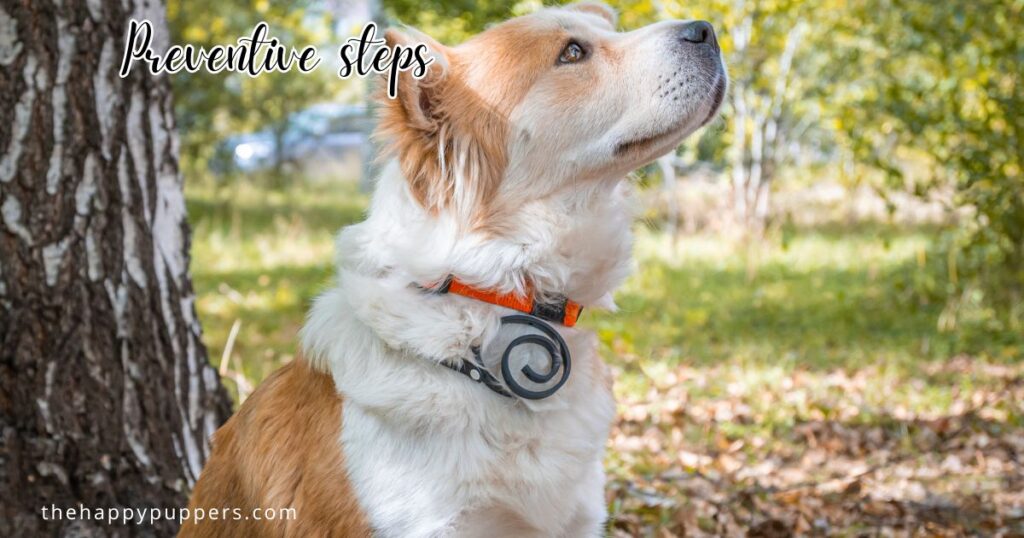
Regular brushing
Brush your dog’s coat on a regular basis to eliminate mats, flea dander, and loose fur. This keeps the coat in good condition, which in turn lessens the likelihood of flea infestations. Brush your pup’s fur once everyday atleast.
Bathing
To get rid of fleas and related detritus, give your pet a bath regularly using a gentle, pet-friendly shampoo. Be careful not to soak in the tub for too long, since this can remove the skin’s protective oils and make existing skin problems worse.
Flea Comb Use
As part of your regular grooming regimen, use a flea comb. Flea combs are an extra line of defense against flea infestations because their fine teeth can snag adult fleas as well as flea dirt in dogs. Ensure that this becomes a part of your daily routine if you have faced flea infestation before.
Application of Flea Control Products:
Medications
Give your pet the flea preventatives that your vet has prescribed, whether that’s a topical therapy or an oral drug. These products offer flea protection for different amounts of time by killing and repelling the pests (Blue Cross).
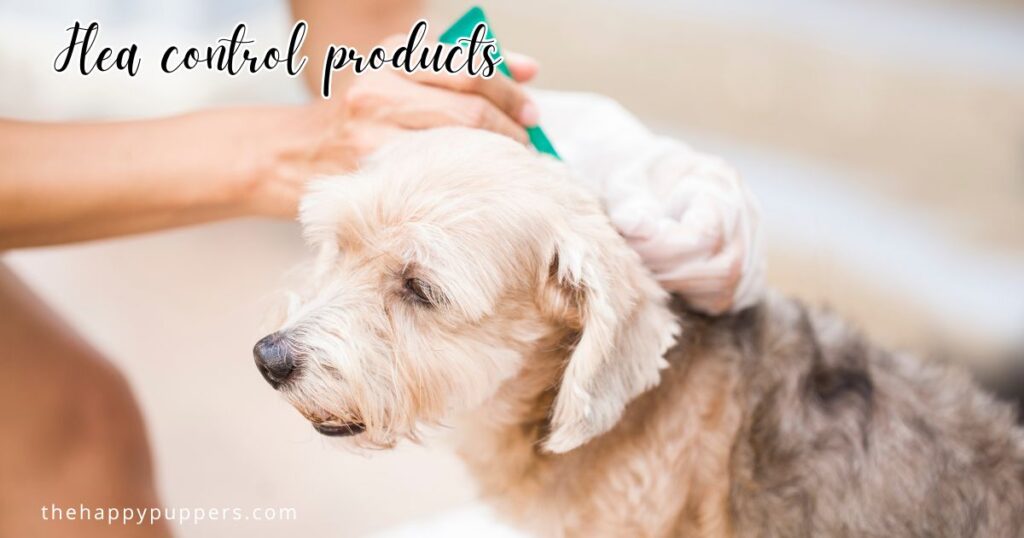
Flea Collars
As I mentioned before, to prevent flea infestation, think about getting a collar that releases pesticides. Before you buy a collar, measure your dog to make sure it fits properly.
Direct Topical Application:
Rub topical treatments into your dog’s skin. Fleas and other parasites can be effectively and long-term protected with these treatments. Make sure that you engage in this step before you allow your dog to get out, whether it is to the backyard or on walks.
Regular check-ups
Get your pet in for checkups with the vet on a regular basis so you can review and revise any flea prevention plans. In light of your dog’s specific requirements, a veterinarian can advise you on the best items to use.
Keeping Your Home Clean for Your Pets:
- Please remember to vacuum your home on a regular basis, especially in areas where your dog tends to spend a lot of time. Flea eggs, larvae, and pupae can be more easily removed from the environment in this way.
- To get rid of fleas and their eggs, wash your dog’s blankets, bedding, and other linens in hot water. Flea life cycle is interrupted by frequent washing.
- Mowing the grass and trimming the bushes should be part of your routine yard maintenance. Fleas love grass and other outside areas, so it’s important to keep your yard clean to avoid getting them.
- Environmental flea treatment products are safe for dogs and can be applied in the form of sprays or powders to locations where your dog spends time.
- All surfaces that fleas could hide in are included in this. This includes carpets, upholstery, and more.
To keep your dog healthy and happy, you should make these preventative steps a regular part of your routine to lessen the likelihood of flea infestations. The most effective method for flea prevention is a comprehensive strategy that includes frequent grooming, good hygiene, preventative medicine, and a clean living space.
Opting for Expert Assistance
When It Is Necessary to See a Veterinarian?
Determined Flea Infestation
Seek veterinary advice if your canine continues to be infested with fleas after trying over-the-counter or home solutions. In order to determine the root causes of the infestation and create a more effective treatment strategy, it is best to seek professional assistance.
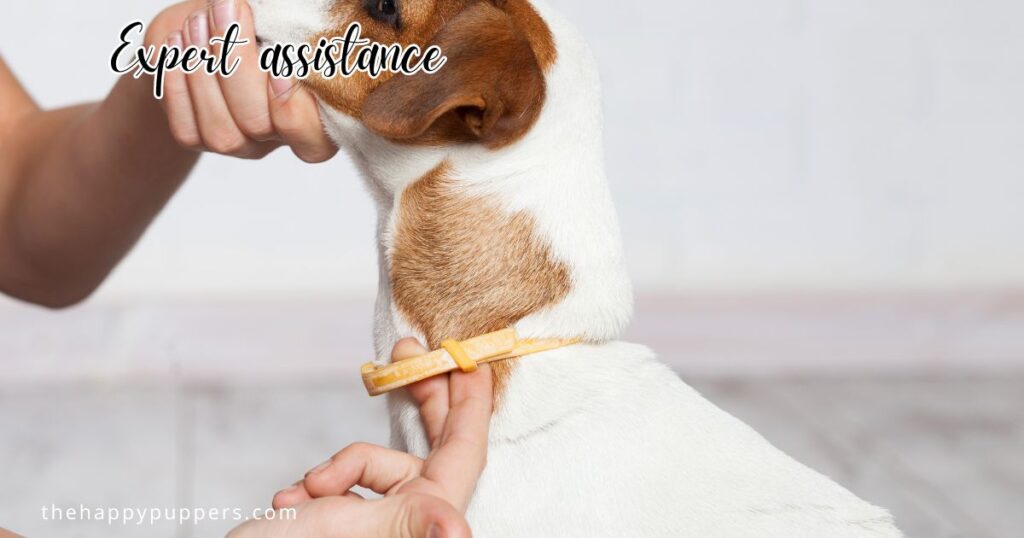
Allergic Reactions:
If your canine exhibits symptoms of a flea bite allergy, such as severe itching, redness, or inflammation of the skin, you must contact your veterinarian without delay. If not addressed, allergic reactions might become much more severe.
Rule out flea issues
It is crucial to rule out flea-related difficulties if your dog exhibits inexplicable health symptoms including lethargy, changes in appetite, or digestive problems. Fleas can spread infections. The first thing to do is quarantine your dog from the other animals in the house and take him to the vet as soon as possible.
Pups and senior dogs
Protected populations, including pups, the elderly, and pregnant canines, require extra attention. For flea treatments that are safe and effective for your pet, it’s best to consult a veterinarian. Be very careful if your pup falls in either of these categories.
Treatment Options for Fleas by Experts:
Medications on Prescription
Flea treatments, whether applied topically, taken orally, or administered intravenously, are available from veterinarians. In comparison to their OTC counterparts, these tend to have stronger and more long-lasting effects.
Flea Baths and Dips:
Veterinarian-administered flea baths and dips effectively remove adult fleas from a dog’s body. Medicated dips or shampoos formulated to eliminate fleas may be part of the treatment plan. They may also provide you the bath and dip ingredients for you to take care of your pup at home.
Laser Therapy:
One cutting-edge option for treating flea-related skin disorders and speeding up the healing process is offered by some veterinary clinics. Inflammation and pain caused by flea bites can be alleviated by laser therapy.
Tailored treatment approach
After assessing the dog’s unique requirements and the extent of the flea infestation, veterinarians can develop all-encompassing treatment regimens that can be administered in the comfort of their own homes. Medication, environmental therapies, and preventative actions may all play a role in this.
The Significance of Prevention and Follow-Up Care:
Regular Vet Checks:
Make sure to schedule follow-up consultations with your veterinarian so you can track your dog’s progress and make any required adjustments to the treatment plan. Maintaining the efficacy of preventative measures and dealing with any remaining concerns requires regular check-ups.
Ongoing Flea Prevention
Following your veterinarian’s advice for ongoing flea prevention is important, even after the infestation has been managed. The best way to keep fleas at bay and shield your dog from future infestations is to treat for prevention.
Follow the instructions
In order to maintain a flea-free house and yard, it is important to follow the veterinarian’s recommendations about environmental management. In order to avoid reinfestations, it is crucial to maintain a clean atmosphere.
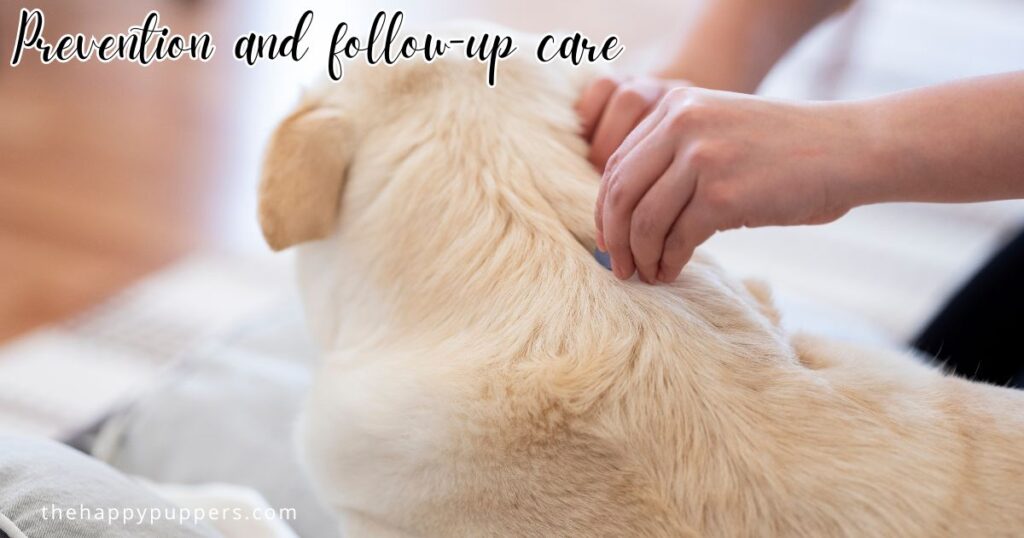
Veterinary Advice on Flea Control
Consult your vet for advice on how to effectively rid your pet of fleas, how to groom them properly, and which preventative products are best for your pet. Pet owners can take charge of their dogs’ health and prevent flea infestations by educating themselves on the topic.
Finally, if your flea problem persists despite your best efforts, or if you want guidance that is particular to your dog’s needs, you must seek professional aid. The management and prevention of flea infestations require a holistic approach that includes follow-up treatment and preventative measures.
Exploring The Happy Puppers Categories
I’m not just here to explain how to get rid of and prevent flea dirt in dogs — I’m here to empower you to be the best dog parent possible with holistic pet care insights.
Dog Behavior Hub
Understand your pup’s actions with expert behavior guides
✔️ Stop puppy nipping behavior: Survival guide
✔️ Dog toys importance in developmental stages
✔️ Training Rescue Terriers: A Complete Guide
Dog Health Hub
Learn how health impacts behavior
✔️ Dog teeth discoloration : causes and remedies
✔️ Pup has worms? Puppy deworming guide
✔️ Gum diseases in dogs: the complete guide
Dog Breeds Hub
Train your pup to curb unwanted habits
✔️ French Bulldog puppies – a complete guide
✔️ Golden Retriever Puppies: Complete Training Guide
✔️ Pocket Pitbull: understanding the breed
Dog Nutrition Hub
Easily fuel your pup with balanced diets for better behavior
✔️ Bone broth for dogs: dog snack
✔️ Apple Cider Vinegar For Dogs
✔️ Benefits of coconut oil for dogs
Dog Grooming Hub
Transform your pup’s look with gentle, grooming using simple techniques to keep them happy and healthy!
✔️ Petco Grooming: Your Ultimate Guide in 2025
✔️ Flea Collars: Do they really work?
✔️ Dog grooming near me 2025
DIY for dogs
Unleash your creativity with fun and easy DIY projects to delight your furry friend!
✔️ DIY indoor activity course for dogs
✔️ Amazing HOMEMADE dog toys
These complement your dog care journey.
Conclusion
To sum up, flea infestations can have a major negative effect on a dog’s health, so it’s crucial to take preventative and curative actions right once. Fundamental stages in keeping a clean and comfortable living space for our pets include identifying flea dirt through regular brushing and watchful inspection. A multi-pronged strategy for flea infestation management can be achieved by combining over-the-counter or prescription flea medicines with natural remedies when supervised by a vet.
By incorporating these several strategies into an all-encompassing plan for flea control, dog owners can protect their pets from flea-related diseases and the pain they bring. When it comes down to it, the best way to make sure our dogs are healthy and happy is for pet owners and vets to work together.
If you wish to become the best guardian to your dog and not miss out on any new dog care tips and tricks about psychology, training, grooming and general care, subscribe to The Happy Puppers newsletter. The subscription option is present in the sidebar. If you love watching videos, then you should also subscribe to the YpuTube channel of The Happy Puppers, Shruti and Delta. Do not forget to ring the notification bell and set it to ALL. This way YouTube will not miss out on notifying you whenever a new video releases from the channel. Feel free to put down your queries and comments in the comment section, I will be happy to help.
See you in my next blog post
Frequently Asked Questions
Keep an eye out for those tiny, mysterious dark specks that decide to set up camp on your dog’s fur or bedding. Whip out a fine-toothed comb, perform a white paper magic trick, or investigate the covert flea hideouts like the base of the tail, neck, and behind the ears.
Enter the realm of natural wonders, featuring diatomaceous earth, essential oils, and apple cider vinegar, all ready to repel those flea troublemakers. However, before unleashing the magic, it’s wise to consult the wise wizards of veterinary wisdom to ensure these remedies are a safe bet for your unique furball.
Flea dirt appears as tiny, dark, reddish-black specks, resembling ground black pepper or coffee grounds. It’s often found in clusters on your dog’s fur or bedding, especially near the tail base, belly, or neck. Use the paper towel test to confirm: wet specks turn reddish-brown due to digested blood.
Unlike regular dirt, which is clumpy and doesn’t change color when wet, flea dirt is granular, reddish-black, and turns reddish-brown on a damp paper towel due to its blood content. It’s a clear sign of fleas, unlike dirt, which is environmental debris.
About the Author
Dr. Shruti Bhattacharya is the founder and guiding force behind The Happy Puppers, combining a Ph.D. in Immunology with decades of direct canine care experience. Her passion for the well-being of dogs has taken many forms:
- Academic & Scientific Rigor – Dr. Shruti applies a science-based approach to pet care, enriched by her training in immunology.
- Hands-On Street Work – Over the past 10+ years, she has personally cared for 30+ street dogs, tending to their health, training, and rehabilitation, even as she relocated and continued caregiving with 15 dogs, and currently supports 5 local neighborhood dogs outside her apartment.
- Instinctual Bond with Dogs – From stray pups to fostered companions, even strangers recognize her as a safe and trusted friend to dogs—drawn to her calm presence and empathy.
- Personal Pack – She’s the proud canine mom of Delta, a German Shepherd–Pitbull mix; Zeus, an energetic Labrador mix; and Alpha, a curious Indian pariah pup—each inspiring her mission through their daily lives.
Through The Happy Puppers, Dr. Shruti shares science-backed advice, empathetic insight, and evidence-based tips designed to empower dog guardians worldwide. The purpose of this is to blend real-world experience with academic expertise, helping every dog feel safe, loved, and thriving.

Follow me on:
Disclaimer
This content is for informational purposes only and not a substitute for professional veterinary or grooming advice. Consult a veterinarian for specific dietary concerns.
References
- PetMD. What Is Flea Dirt and How to Get Rid of It.
- The Spruce Pets. How to Identify and Remove Flea Dirt on Dogs.
- Chewy. What Is Flea Dirt?
- Frontline. Flea Protection for Dogs.
- Warrick Veterinary Clinic. Spotting and Treating Fleas on Dogs.
- Blue Cross. Dog Flea Advice.
- Bitam, I., Dittmar, K., Parola, P., Whiting, M. F., & Raoult, D. (2010). Flea Infestation and Its Health Risks. Emerging Infectious Diseases, 16(11).

